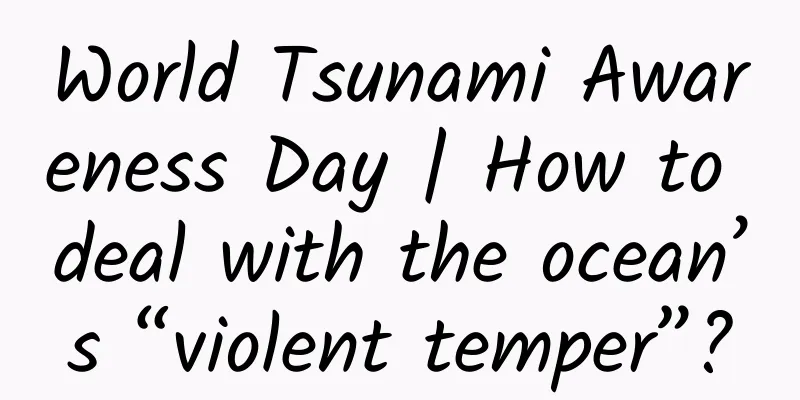World Tsunami Awareness Day | How to deal with the ocean’s “violent temper”?

|
Today is World Tsunami Awareness Day. When a tsunami strikes, it often causes great damage to buildings and property on land, so it is very important to prepare for tsunamis. To prepare for tsunamis, it is especially important to first understand the "violent temper" of the sea. The picture is a copyrighted stock picture. Reprinting it may cause copyright disputes. 01 The diverse “ violent tempers ” of the ocean: What types of tsunamis are there ? A tsunami is essentially a large ocean long wave with a speed of 700 to 800 kilometers per hour and a wavelength of hundreds of kilometers. It propagates extremely fast and can travel thousands of kilometers with very little energy loss. According to their manifestation , tsunamis can be divided into regressive tsunamis and transgressive tsunamis . Recession tsunami : refers to the abnormal ebb of the sea water or the flooding of rivers in the coast, islands or bays, and then the sea water suddenly sweeps in and rushes to the land. A typical case: the Chilean earthquake tsunami in 1960, the sea showed an abnormal ebb tide phenomenon. Transgressive tsunami : It is manifested as a sudden rise in sea level, forming a water wall several tens of meters high, rushing towards the coastal land, and then the sea water suddenly recedes. Typical case: On May 26, 1983, the tsunami caused by the 7.7-magnitude earthquake in the Central Sea of Japan, the tsunami wave first manifested itself as an abnormal high tide phenomenon on the coast. Tsunami hits houses (Picture from copyright gallery, reprinting may cause copyright disputes) According to the cause of formation , tsunamis can be divided into earthquake tsunamis, volcanic tsunamis and landslide tsunamis . Earthquake tsunami : refers to the strong disturbance of seawater caused by the rapid rise and fall of the seabed topography when an earthquake occurs on the seabed, resulting in "downward type" and "upward type" tsunamis. Typical case: In March 2011, a strong earthquake of magnitude 9.0 occurred in the northeastern waters of Japan and triggered a tsunami, causing heavy casualties and property losses in the area. Volcanic tsunami : refers to a tsunami caused by a volcanic eruption. A typical case: the tsunami caused by the eruption of Krakatoa, an Indonesian volcanic island in 1883, had waves as high as 40 meters, washing away more than 100 villages in Java and Sumatra. Landslide tsunami : refers to a tsunami caused by landslides in coastal or seaside areas, which causes sediments to fall into the sea. Compared with earthquake tsunamis and volcanic tsunamis, tsunamis caused by landslide tsunamis have higher wave heights, greater energy, and are more difficult to detect. Typical case: On September 16, 2023, a mountain collapsed in Dixon Fjord, Greenland, causing about 25 million cubic meters (equivalent to 10,000 Olympic swimming pools) of material to slide into the sea, causing rock and ice avalanches, triggering a huge tsunami up to 200 meters high, and generating earthquake signals that affected the world and lasted for 9 days. In 2022, a volcano in the South Pacific island nation of Tonga erupted violently recently, triggering a tsunami. The picture shows a satellite image of Tonga's Hongaha Apai Island taken by the Worldview02 satellite on April 11, 2021 (left) and a satellite image of the island after the volcanic eruption taken by the Gaofen-1 satellite on January 17, 2022. The orange curve is the original outline of the island marked according to the geographic coordinates. (Photo source: Xinhua News Agency) Depending on the distance from where the tsunami occurs , tsunamis can be divided into two categories: transoceanic tsunamis and local tsunamis . Transoceanic tsunami : refers to a tsunami that occurs far away and travels across the ocean or from a long distance. A typical case is the tsunami that occurred in Indonesia in late 2004 and affected Sri Lanka thousands of kilometers away. Local tsunami : refers to a tsunami that is relatively close to the source of an earthquake or tsunami and the affected coastal areas. Due to its short warning time, it often causes more serious disasters. 02What "defense" did the sea's "violent temper" break? A brief discussion on the hazards of tsunamis The harm caused by tsunamis to inland and coastal areas mainly manifests itself in two aspects: direct harm and indirect harm . Direct hazards of tsunamis : causing flooding, impacting ships and port facilities and buildings, and shaking the foundations of bridges, seawalls and buildings, causing them to collapse. Indirect hazards of tsunamis : causing fires in buildings, ships, oil depots and gas stations, triggering sewage, oil and hazardous chemical pollution, and causing the outbreak and spread of epidemics, bringing huge damage to seaports, towns and villages. On December 23, 2018, in Pandeglang, Banten Province, Indonesia, the tsunami left a mess (Photo source: Xinhua News Agency) 03 “Curing” the ocean’s temper: Early warning of tsunamis In order to reduce the losses caused by tsunamis and improve the public's awareness of tsunamis and emergency response capabilities, all countries have established effective early warning systems and protective measures. In 1997, American scientists invented a tsunami warning device that measures pressure data through pressure sensors placed on the seabed, and then transmits the measured data to satellites through buoys on the sea surface, forming a deep-sea tsunami assessment and reporting system. For earthquake-type tsunamis, warning systems are usually issued together with earthquake warnings or immediately after them. However, the range of most tsunami warnings is often much larger than that of earthquake warnings. This is because compared with earthquakes, the energy attenuation of tsunamis is not obvious and they can often travel long distances. For example, in 2023, the US National Tsunami Warning Center issued a tsunami warning for the coast within 1,000 kilometers near the Loyalty Islands east of New Caledonia in the southwest Pacific. As a country with a vast sea territory, tsunamis are not the main marine disaster in my country, and there are relatively few records of tsunamis. However, my country also has strong tsunami forecasting and analysis capabilities. As early as 1983, my country became a member of the International Tsunami Coordination Group. At present, it has two tsunami warning centers: the State Oceanic Administration Tsunami Warning Center and the South China Sea Regional Tsunami Warning Center. In 2014, led by the State Oceanic Administration, Chinese scientists independently developed a tsunami warning buoy that can complete the numerical forecast of tsunamis in the Pacific, Northwest Pacific and South China Sea within 30 seconds to 5 minutes, and can capture the information of the seabed abyss more accurately and timely, greatly improving China's emergency disposal and response capabilities to tsunami disasters. 04 Turn "violent temper" into "vitality": What can we do with tsunamis? As an ocean dynamic force with enormous energy and destructive power, taming and conquering tsunamis has always been the dream of scientists from all over the world. The most feasible and practical way is to use the regular oscillations of sea water generated by tsunamis to generate electricity and convert the energy of tsunami waves into electrical energy. When tsunami waves hit specific devices, these devices will capture and collect wave kinetic energy, convert the wave energy into mechanical energy, and then convert it into electrical energy through hydraulic or pneumatic pressure. In 2005, the wave power station in Shanwei City, independently developed and built by the Ocean Energy Laboratory of the Guangzhou Institute of Energy, Chinese Academy of Sciences, converted the mechanical energy of wave motion into electrical energy through a periodic array of low-frequency resonators, and built the world's first independent and stable wave energy system, realizing the stable conversion of wave energy into electrical energy. Of course, although there are such wave power stations, due to the instability of tsunamis, the large-scale use of this technology is still under technical development and needs to overcome technical, economic and environmental challenges. September 2024. The "Jida No. 4" self-propelled mixed flow pneumatic wave energy power generation platform, a scientific research project of Professor Yang Shaohui's team from the College of Marine Equipment and Mechanical Engineering of Jimei University, was successfully launched (Photo source: Xinhua News Agency) 05A "mysterious" case in geological history, the truth is revealed because of the tsunami? Tsunamis and undersea earthquakes coexist and are not uncommon in geological history and stratigraphic records. The most typical example is the discovery of the mechanism of formation of bamboo-leaf limestone . Bamboo leaf limestone is a kind of limestone. It is called bamboo leaf limestone because its rock cross section often has gravels and is bamboo leaf-shaped. Bamboo leaf limestone appears in large quantities in the Cambrian and Ordovician systems of the North China Platform in my country. Typical production areas include Cangshan, Pingyi, Zhangxia and other places in Shandong. The gravels in the limestone vary in size, generally 0.3 cm to 10 cm long, mostly mud-crystal calcite, and the cement and filling materials are mostly microcrystalline or fine-crystalline calcite. The gravels are often accompanied by cross-bedding, cracking, ripples and other structures. Bamboo leaf-shaped limestone (Photo source: Screenshot of Douyin video) Bamboo-leaf-shaped limestone is an ornamental stone that is widely distributed throughout the world and is loved by people all over the world. However, there have been many different opinions about its origin and its wide distribution range. Until 1985, American scientist Michael D. Wilson was inspired by the chaotic sedimentary sequence after a tsunami and discovered that these so-called bamboo-leaf-shaped stones were formed by storm flow erosion and transformation of consolidated or semi-consolidated limestone caused by the tsunami. The truth of an unsolved case in geological history was revealed because of the tsunami. Outlook In recent years, with global warming and frequent extreme weather, the harm of tsunamis to my country's coastal areas and the South China Sea, especially Taiwan Island, has further intensified, requiring sufficient attention. Image source: Screenshot of the National Emergency Warning Information Release Network On April 3, 2024, an earthquake in the waters of Hualien County, Taiwan Province, triggered my country's first tsunami level Ⅰ red alert, which had a certain impact on the eastern part of Taiwan. Therefore, continuing to develop more advanced tsunami detection and monitoring instruments and better tsunami warnings is a natural part of protecting the tranquility of my country's seas and the safety of the people. Author: Liu Hanbin, PhD in Geology, Senior Geological Engineer Reviewer: Liu Bangjun, Associate Professor and Master Supervisor, School of Earth Sciences and Engineering, Hebei University of Engineering Produced by: Science Popularization China |
<<: There are tea trees in the tea garden, so why plant grass?
>>: Stanford’s latest research: Be careful of “cliff-like aging” at 44 and 60 years old!
Recommend
Weilai’s conference call indicated that the sharp decline in profit margins was mainly due to the recall of 4,803 ES8s.
On September 24, 2019, NIO released its second qu...
Global warming slows down the Earth's rotation! Our time will also change as a result...|Environmental Trumpet
Hello everyone, this is the 8th issue of the Envi...
Volkswagen recalls some diesel models in the country due to emissions cheating
Recently, Volkswagen (China) Sales Co., Ltd. file...
User growth: build your own traffic pool!
Build your own traffic pool, expand it through pr...
Sneezing can cause lumbar fracture! Don’t just drink milk to supplement calcium, there are 7 kinds of vegetables with higher calcium content than milk!
Recently, Ms. Ding, who is over 70 years old, fro...
I heard that marble has radiation? The mineral that can really harm you is...
"Marble has radiation, it is dangerous to ke...
Important iOS functions are no longer usable. The vulnerability from 2 years ago has not been fixed yet.
If anyone wants to be on the hot search these day...
Beware of the trap! "AI fortune-telling" is "spying" on your privacy
Your browser does not support the video tag With ...
Australia bans artificial stone, causing incurable diseases for 600 people
Recently, Australia announced at a conference tha...
Brand marketing promotion: the underlying logic behind Durex’s content marketing!
On April 19, the cross-border marketing cooperati...
Can’t write information flow advertising copy? There is a template here, just use it!
Many friends often complain to me: " Informa...
SaaS product promotion and customer acquisition guide!
Today, let’s talk about how to achieve rapid and ...
The Essential Guide to App Store ASO: 3 Steps to ASO Optimization
ASO provides free, high-quality users to your And...
These four ways of feed flow advertising can turn your readers from being "raped" to "enjoying"
The trend of the mobile Internet era is irreversi...
WeChat Mini Programs Major Upgrade: Open Cloud Development
After a rare month of silence, WeChat Mini Progra...









